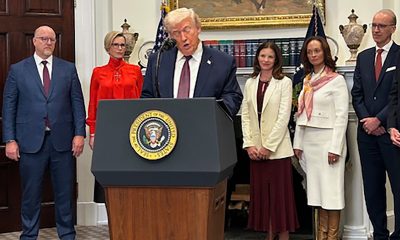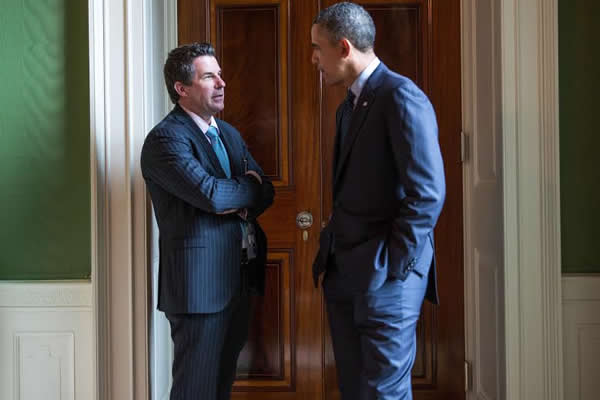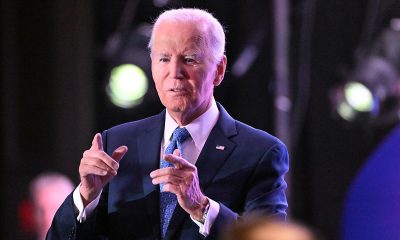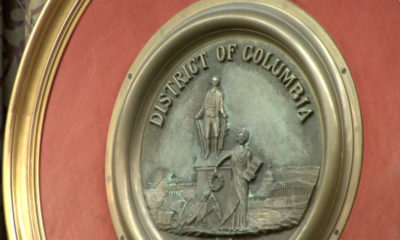National
Obama speechwriter reflects on marriage ruling, Charleston shooting in new book
Cody Keenan revisits 10 critical days from unique vantage point
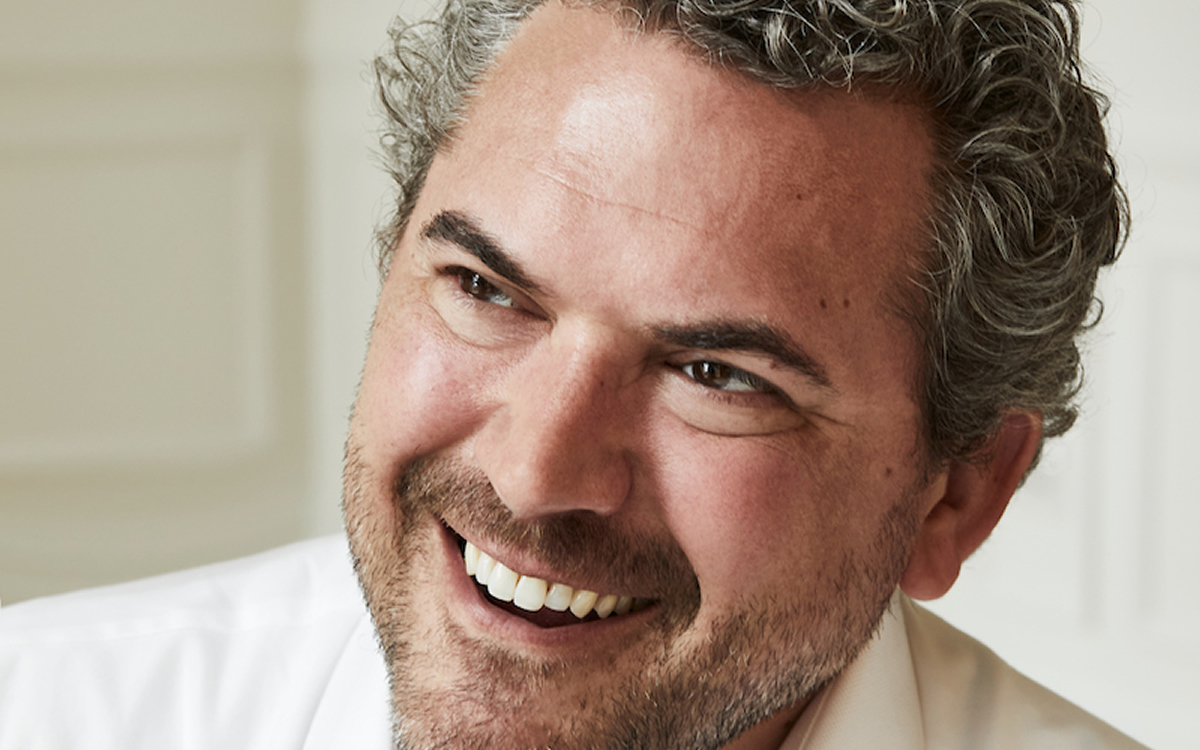
Cody Keenan, director of speechwriting for President Obama, had a prominent vantage point in the White House during an eventful 10 days that included recovery from a violent memory underscoring lingering issues with racism.
Those 10 days, which saw the U.S. Supreme Court ruling in favor of same-sex marriage and upholding Obamacare as well as Obama’s speech in the aftermath of a racist shooting at a Black church in Charleston, are now encapsulated in his new book, “Grace: Barack Obama and Ten Days in the Battle for America.”
The Washington Blade spoke with Keenan about his book in an interview on Tuesday that includes an exchange the author and this reporter shared from different perspectives during Obama’s speech in the Rose Garden after the Supreme Court’s ruling for same-sex marriage.
Read the full interview below:
Blade: Why was the time now for this book?
Cody Keenan: There’s a couple of reasons for that. No. 1 is sort of technical. I was still working for President Obama up until the beginning of 2021. And so I didn’t feel appropriate to start writing a book that’s largely about him as long as he was paying me. So that’s the technical answer.
The other is I’d just been rolling these 10 days around in my head for a while. You know, it doesn’t coalesce all at once. You don’t wake up in the morning after marriage equality and Charleston and say, “OK, I’m going to write a book.” It really took the Trump years to actually crystallize it in my head because suddenly we were living through the opposite. We come through this kind of amazing 10-day burst of progress. That, of course, is not limited to 10 days. It was a result of decades of effort, and then the backlash to it. It makes it seem all that more sharp.
Blade: I think our viewers are going to be very interested in the discussion on the marriage ruling and the potential outcomes that you depict in the book. Looks like there was a lot of anxiety behind closed doors about the decision as well as the possible decision on the Affordable Care Act. Do you think that anxiety was shared by President Obama?
Cody Keenan: I’ll never know for certain. He didn’t show his hand like that. He never looked at the drafts we wrote the kind of ‘in case of emergency break glass’ drafts. He just he never did. Not on election nights, not on Supreme Court rulings. It’s not that he’s cocky, he was confident. I think it was more confident in the ACA decision because he knew that it shouldn’t have been there in the first place. So, I don’t so I don’t know how he felt about the marriage equality ruling coming in. I know how he felt about it after the fact. You can watch his remarks on YouTube, which are pretty extraordinary.
They were fairly short as written and then he decided to keep going, which is always interesting as a speech writer, knowing that the remarks are over. I love watching him ad lib, but when the remarks are over, and he just keeps going and there’s no runway to land that plane and that’s always a little interesting. On the page, it’s not a lot but he was really thinking as he was saying the words, as he was tying it to the countless small acts of courage with people who came out and parents who love their kids in return, people who just who made this happen through decades of efforts. And then, he tied this into Bobby Kennedy, which is really exciting. So that was kind of fascinating to watch.
I’ve always thought that he was genuinely moved by the fact that America had come so far and, relatively speaking, so fast on the equal rights issue like that. … I asked him later why he ad-libbed all that and why he was talking so slowly. He just he said he was up too late, reworking my speech, which isn’t true, because he gave it back to me like 11 p.m. But no, I think he was genuinely proud of the country, and then a whole lot of people at that point.
Blade: Yeah, I remember that day very well because I was actually right in front of Obama as he was giving those remarks. I’m a White House reporter, so I wanted to be able to see these remarks firsthand. I was at the Supreme Court and I rushed back to the White House. I actually missed the call time just by ever so slightly but a when the White House staffer saw me there, she escorted me to the Rose Garden. And I was seated there, then press saw me there and they knew how important it was to me so they allowed me to take the seat in the front row where normally the major news stations sit. I was a few feet away from Obama, as he was saying those words.
Keenan: Oh wow. Well, this isn’t a two-way interview, obviously, but I’d be very curious afterwards as to how you were feeling that morning before and then.
Blade: For me, it was a very surreal and very powerful experience to have this issue that has been a really important issue for so many people, and really animated my work for so long, to more or less reach its conclusion. And one thing that really stood out to me was it just seems to me like when I was writing about marriage equality, it was really of interest to a certain group of people and other people really weren’t that interested. But on that day, it was a reminder that that wasn’t the case. Because remember, President Obama gave his remarks and then the entire White House staff circled around the perimeter of the Rose Garden and gave applause and it was just it was very touching, very moving. I don’t think they did that for the ACA speech. It struck me just how powerful it was because people wanted to embrace that decision with that reaction.
Keenan: The difference there is that we had — this is who people are, we had so many colleagues that — I just dreaded the idea of having to look a colleague in the eye or a friend had it gone the other way. There was anxiety and we were also relieved and excited that it went the right way. There was anxiety that morning. I guess I can always speak for myself, but as a Democrat and as a Chicago sports fan, I am never satisfied until it’s over…I’m always hopeful we’re gonna win, but I don’t ever expect. So until that really came down, I was pretty anxious for sure.
Blade: Was there anything during that speech that surprised you. I think you said Obama said a few things you didn’t think he was going to say but just anything that otherwise happened that just really opened your eyes on that either after the ruling or in his remarks?
Kennan: The remarks didn’t surprise me…I just thought it was so interesting that he kept going. He always gave long speeches, but for a speech to be over on paper and for him to not want to stop. You know, he didn’t want to stop and just wanted to say more, and I thought that was so fascinating and awesome and exciting, and then obviously five minutes after that we need to head down to Charleston.
Blade: I do want to ask you about Charleston, but one thing I want to ask you about was that was the night that the White House was lit up in rainbow colors. And I’m just wondering if you were part of the discussion, if you aware of that, if you remember your reaction to that?
Keenan: I was not a part of the discussion. I didn’t know what was going to happen until that morning or the morning after, I can’t remember. We were on the Rose Garden for the remarks, and Denis McDonough came up and told me, “God, that’s cool.” It’s one of those things where you wish you thought of it because it seems so obvious. I’ve talked to a lot of people for this book. I talked to Jeff Tiller and Tina Tchen. [Jeff Tiller was an Obama White House LGBTQ media liaison.] And one of the coolest things Jeff told me was he was the one that kind of spearheaded this whole thing and found funding for it, found quotes from contractors and was out there kind of tearing his hair out when the lights weren’t necessarily working.
But the coolest thing he said is they were talking about what to do if the Supreme Court ruled the other way. Do they light it up? And Jeff said, “Yeah, it’s even more important then.”
Blade: That’s definitely something that was planned for. I was really surprised at how they were able to keep it under wraps for so long. It was a surprise to everyone I think.
Keenan: The only bummer is that Obama was gonna fly around the front of the White House on Maine One to look at it. But I don’t think anybody remembered this was like the longest week of the year daylight-wise. So we’ve been back for maybe two hours before it actually started, before colors actually started getting visible.
Blade: So on the Charleston speech, a much more somber moment, do you think having the nation’s first Black president at the time offered us something unique in that moment?
Keenan: Sure. I talk a lot about how difficult it was to write about race just because we haven’t all lived the same experiences. It may have actually been more difficult to write that speech had it been for a white president to deliver. The fact that a Black president gave that eulogy was pretty remarkable. It’s not just that he is a walking sign of progress and change, and a lot of people didn’t like that, hence some of the backlash we’re living in now.
….He can speak to race and the possibilities of reconciliation and change, I think, more so than a white president could have in that moment. It’d be easy for a white president to just condemn it, but for a Black president to go up and find the words is easier symbolically. It might have been more difficult on the page. I really don’t know. But it was a quintessential hit, what he did to the text, using the lyrics to Amazing Grace to kind of create the space for people to change their minds, the space for people to — the whole song was written by a slave owner who changed his ways, to repent. And it’s sort of the same thing, if anything’s ever going to wake us up to the long legacy of racism and to what gun violence is doing, that’s what the Confederate flag means to some people. It has to be this. So in some ways, I don’t know the answer as to whether it be easier or harder, but he did bring something unique to it just by virtue of his experience.
Blade: Did you think the Charleston shooting represented the last dying breath of racism in the United States, or that it was a prelude of things to come?
Keenan: I don’t think either. I could see the argument for each but I don’t think either. We’ve obviously endured racial violence for centuries. A Black church was set on fire in Massachusetts the day Obama was elected. He had more threats against him than any other president. It’s what we live with. So it definitely wasn’t the start, and it’s not the end. I mean, in a lot of ways, the fact that Donald Trump announced his candidacy the day before the shooting, it’s just kind of an awful reminder that a president’s words can unleash a lot of bad things, and at their best they can inspire the best in people, at their worst they can turn people against each other and kind of let loose the country’s worst demons and create permission structure for people to act out their political violence.
What kind of linked those things that week, and even Obamacare to a lesser extent, is who are we? Do we stand up to white supremacy and bigotry? Or do we allow this to continue, do we allow state legislators to fly the Confederate flag over where Black people live and work and worship? Do we allow the Supreme Court to basically codify bigotry by saying, “No, you can’t get married”? Do we allow them to say sorry to millions of poor people and working people you don’t get to have health insurance unless you’re wealthy? And like all those things just came to a head in the same week.
Blade: So my final question for you is what kind of impact would you like for your book to have?
Keenan: There’s kind of three buckets here. One is first I really do think it’s an important story to tell for history. I want people to read about this some day as this kind of amazing spasm of progress that is not due to one president, but to two generations of people who marched and fought and bled for this. I also teach speech writing at Northwestern, I want young people who are in college now and look at politics and think, “Why would I want to do that?” and change their minds. I want them to think this is a place that’s worth my time and effort. It can actually be fulfilling and collegial and fun.
And anyone else myself included who’s started to feel really cynical in recent years, and there’s plenty of reasons for it, I wanted to throw that up. I’ve gotten some of the greatest feedback so far from a couple strangers who reached out to say they sign up to knock on doors and one of my former colleagues texted this morning to say just reminded me in politics in the first place, and that’s what I want. I want people to read it and say, “You know what, for all the awfulness out there and for the act of undermining of our democracy and the heinous cruelty, we’re still in charge.”
{Editor’s Note: This interview has been edited for length.]
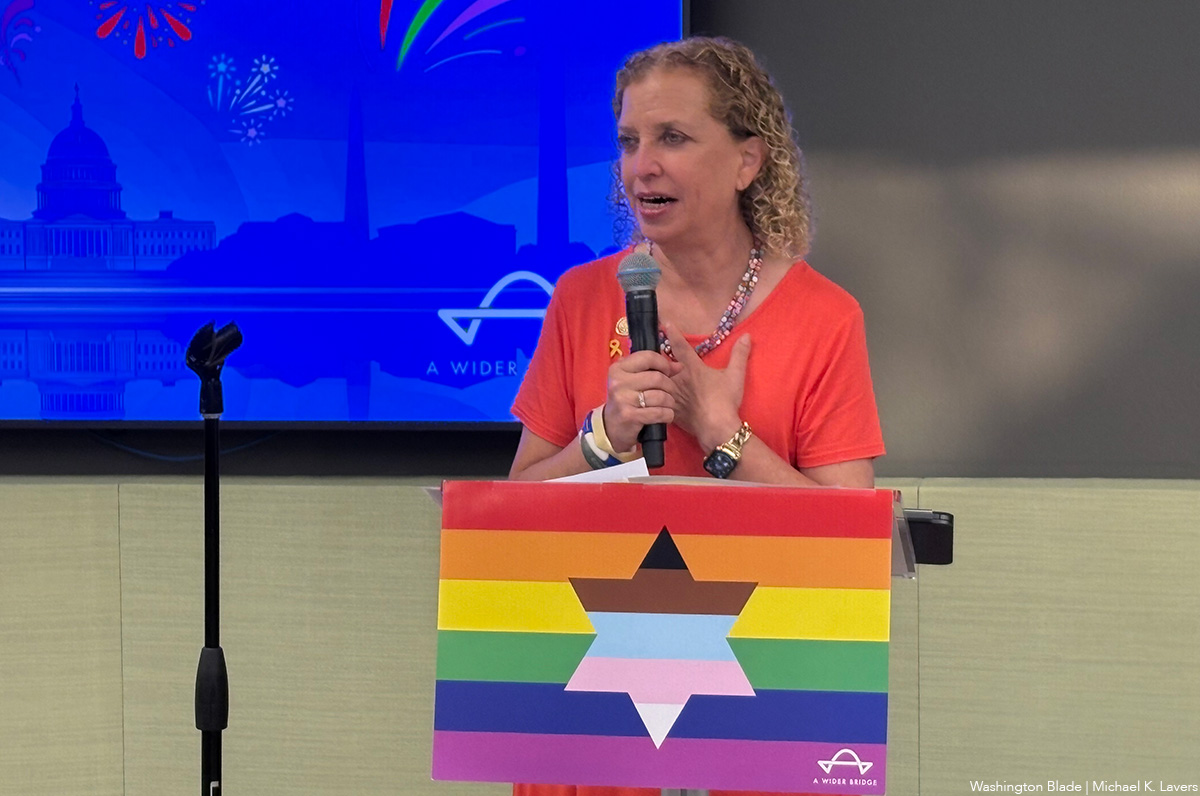
A Wider Bridge on Friday announced it will shut down at the end of the month.
The group that “mobilizes the LGBTQ community to fight antisemitism and support Israel and its LGBTQ community” in a letter to supporters said financial challenges prompted the decision.
“After 15 years of building bridges between LGBTQ communities in North America and Israel, A Wider Bridge has made the difficult decision to wind down operations as of Dec. 31, 2025,” it reads.
“This decision comes after challenging financial realities despite our best efforts to secure sustainable funding. We deeply appreciate our supporters and partners who made this work possible.”
Arthur Slepian founded A Wider Bridge in 2010.
The organization in 2016 organized a reception at the National LGBTQ Task Force’s Creating Change Conference in Chicago that was to have featured to Israeli activists. More than 200 people who protested against A Wider Bridge forced the event’s cancellation.
A Wider Bridge in 2024 urged the Capital Pride Alliance and other Pride organizers to ensure Jewish people can safely participate in their events in response to an increase in antisemitic attacks after Hamas militants attacked Israel on Oct. 7, 2023.
The Jewish Telegraphic Agency reported authorities in Vermont late last year charged Ethan Felson, who was A Wider Bridge’s then-executive director, with lewd and lascivious conduct after alleged sexual misconduct against a museum employee. Rabbi Denise Eger succeeded Felson as A Wider Bridge’s interim executive director.
A Wider Bridge in June honored U.S. Rep. Debbie Wasserman Schultz (D-Fla.) at its Pride event that took place at the Capital Jewish Museum in D.C. The event took place 15 days after a gunman killed two Israeli Embassy employees — Yaron Lischinsky and Sarah Milgrim — as they were leaving an event at the museum.
“Though we are winding down, this is not a time to back down. We recognize the deep importance of our mission and work amid attacks on Jewish people and LGBTQ people – and LGBTQ Jews at the intersection,” said A Wider Bridge in its letter. “Our board members remain committed to showing up in their individual capacities to represent queer Jews across diverse spaces — and we know our partners and supporters will continue to do the same.”
Editor’s note: Washington Blade International News Editor Michael K. Lavers traveled to Israel and Palestine with A Wider Bridge in 2016.
The White House
‘Trump Rx’ plan includes sharp cuts to HIV drug prices
President made announcement on Friday

President Donald Trump met with leaders from some of the world’s largest pharmaceutical companies at the White House on Friday to announce his new “Trump Rx” plan and outline efforts to reduce medication costs for Americans.
During the roughly 47-minute meeting in the Roosevelt Room, Trump detailed his administration’s efforts to cut prescription drug prices and make medications more affordable for U.S. patients.
“Starting next year, American drug prices will come down fast, furious, and will soon be among the lowest in the developed world,” Trump said during the meeting. “For decades, Americans have been forced to pay the highest prices in the world for prescription drugs by far … We will get the lowest price of anyone in the world.”
Trump signed an executive order in May directing his administration “to do everything in its power to slash prescription drug prices for Americans while getting other countries to pay more.”
“This represents the greatest victory for patient affordability in the history of American health care, by far, and every single American will benefit,” he added.
Several pharmaceutical executives stood behind the president during the announcement, including Sanofi CEO Paul Hudson, Novartis CEO Vas Narasimhan, Genentech CEO Ashley Magargee, Boehringer Ingelheim (USA) CEO Jean-Michel Boers, Gilead Sciences CEO Dan O’Day, Bristol Myers Squibb General Counsel Cari Gallman, GSK CEO Emma Walmsley, Merck CEO Robert Davis, and Amgen Executive Vice President Peter Griffith.
Also in attendance were Health and Human Services Secretary Robert F. Kennedy Jr., Commerce Secretary Howard Lutnick, Centers for Medicare and Medicaid Services Administrator Mehmet Oz, and Food and Drug Administration Commissioner Marty Makary.
Under the Trump Rx plan, the administration outlined a series of proposed drug price changes across multiple companies and therapeutic areas. Among them were reductions for Amgen’s cholesterol-lowering drug repatha from $573 to $239; Bristol Myers Squibb’s HIV medication reyataz from $1,449 to $217; Boehringer Ingelheim’s type 2 diabetes medication jentadueto from $525 to $55; Genentech’s flu medication xofluza from $168 to $50; and Gilead Sciences’ hepatitis C medication epclusa from $24,920 to $2,425.
Additional reductions included several GSK inhalers — such as the asthma inhaler advair diskus 500/50, from $265 to $89 — Merck’s diabetes medication januvia from $330 to $100, Novartis’ multiple sclerosis medication mayzent from $9,987 to $1,137, and Sanofi’s blood thinner plavix from $756 to $16. Sanofi insulin products would also be capped at $35 per month’s supply.
These prices, however, would only be available to patients who purchase medications directly through TrumpRx. According to the program’s website, TrumpRx “connects patients directly with the best prices, increasing transparency, and cutting out costly third-party markups.”
Kennedy spoke after Trump, thanking the president for efforts to lower pharmaceutical costs in the U.S., where evidence has shown that drug prices — including both brand-name and generic medications — are nearly 2.78 times higher than prices in comparable countries. According to the Pharmaceutical Research and Manufacturers of America, roughly half of every dollar spent on brand-name drugs goes to entities that play no role in their research, development, or manufacturing.
“This is affordability in action,” Kennedy said. “We are reversing that trend and making sure that Americans can afford to get the life-saving solutions.”
Gilead CEO Dan O’Day also spoke about how the restructuring of drug costs under TrumpRx, combined with emerging technologies, could help reduce HIV transmission — a virus that, if untreated, can progress to AIDS. The LGBTQ community remains disproportionately affected by HIV.
“Thank you, Mr. President — you and the administration,” O’Day said. “I think this objective of achieving the commitment to affordability and future innovation is extraordinary … We just recently launched a new medicine that’s only given twice a year to prevent HIV, and we’re working with Secretary Kennedy and his entire team, as well as the State Department, as a part of your strategy to support ending the epidemic during your term.
“I’ve never been more optimistic about the innovation that exists across these companies and the impact this could have on America’s health and economy,” he added.
Trump interjected, asking, “And that’s working well with HIV?”
“Yes,” O’Day replied.
“It’s a big event,” Trump said.
“It literally prevents HIV almost 100 percent given twice a year,” O’Day responded.
A similar anti-HIV medication is currently prescribed more than injectable form mentioned by O’Day. PrEP, is a medication regimen proven to significantly reduce HIV infection rates for people at high risk. Without insurance, brand-name Truvada can cost roughly $2,000 per month, while a generic version costs about $60 per month.
Even when medication prices are reduced, PrEP access carries additional costs, including clinic and laboratory fees, office visits, required HIV and sexually transmitted infection testing, adherence services and counseling, and outreach to potentially eligible patients and providers.
According to a 2022 study, the annual total cost per person for PrEP — including medication and required clinical and laboratory monitoring — is approximately $12,000 to $13,000 per year.
The TrumpRx federal platform website is now live at TrumpRx.gov, but the program is not slated to begin offering reduced drug prices until January.
The White House
EXCLUSIVE: Democracy Forward files FOIA lawsuit after HHS deadnames Rachel Levine
Trans former assistant health secretary’s name changed on official portrait

Democracy Forward, a national legal organization that works to advance democracy and social progress through litigation, policy and public education, and regulatory engagement, filed a lawsuit Friday in federal court seeking to compel the U.S. Department of Health and Human Services to release information related to the alteration of former Assistant Secretary for Health Adm. Rachel Levine’s official portrait caption.
The lawsuit comes in response to the slow pace of HHS’s handling of multiple Freedom of Information Act requests — requests that federal law requires agencies to respond to within 20 working days. While responses can take longer due to backlogs, high request volumes, or the need for extensive searches or consultations, Democracy Forward says HHS has failed to provide any substantive response.
Democracy Forward’s four unanswered FOIA requests, and the subsequent lawsuit against HHS, come days after someone in the Trump-Vance administration changed Levine’s official portrait in the Hubert H. Humphrey Building to display her deadname — the name she used before transitioning and has not used since 2011.
According to Democracy Forward, HHS “refused to release any records related to its morally wrong and offensive effort to alter former Assistant Secretary for Health Admiral Rachel Levine’s official portrait caption.” Levine was the highest-ranking openly transgender government official in U.S. history and served as assistant secretary for health and as an admiral in the U.S. Public Health Service Commissioned Corps from 2021 to 2025.
Democracy Forward President Skye Perryman spoke about the need to hold the Trump-Vance administration accountable for every official action, especially those that harm some of the most targeted Americans, including trans people.
“The question every American should be asking remains: what is the Trump-Vance administration hiding? For an administration that touts its anti-transgender animus and behavior so publicly, its stonewalling and silence when it comes to the people’s right to see public records about who was behind this decision is deafening,” Perryman said.
“The government’s obligation of transparency doesn’t disappear because the information sought relates to a trailblazing former federal official who is transgender. It’s not complicated — the public is entitled to know who is making decisions — especially decisions that seek to alter facts and reality, erase the identity of a person, and affect the nation’s commitment to civil rights and human dignity.”
“HHS’s refusal to respond to these lawful requests raises more serious concerns about transparency and accountability,” Perryman added. “The public has every right to demand answers — to know who is behind this hateful act — and we are going to court to get them.”
The lawsuit also raises questions about whether the alteration violated federal accuracy and privacy requirements governing Levine’s name, and whether the agency improperly classified the change as an “excepted activity” during a lapse in appropriations. By failing to make any determination or produce any records, Democracy Forward argues, HHS has violated its obligations under federal law.
The case, Democracy Forward Foundation v. U.S. Department of Health and Human Services, was filed in the U.S. District Court for the District of Columbia. The legal team includes Anisha Hindocha, Daniel McGrath, and Robin Thurston.
The Washington Blade reached out to HHS, but has not received any comment.
The lawsuit and four FOIA requests are below:
-

 Politics4 days ago
Politics4 days agoLGBTQ Democrats say they’re ready to fight to win in 2026
-

 District of Columbia4 days ago
District of Columbia4 days agoBrian Footer suspends campaign for Ward 1 D.C. Council seat
-

 Opinions4 days ago
Opinions4 days agoLighting candles in a time of exhaustion
-

 Opinions3 days ago
Opinions3 days ago2026 elections will bring major changes to D.C. government

